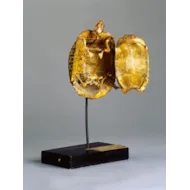A Mounted Anatomical Specimen of a Greek Marginated Tortoise
A Mounted Anatomical Specimen of a Greek Marginated Tortoise
The hinged carapace opening to reveal the skeleton
With old label reading ‘Testudo Mauritanica Europe’. Musees Scolares, Emile, 23 Rue de la Monnaie, Paris.
19th Century
Size : 27.5 cm high – base : 15 cm wide, 10 cm deep – 10¾ high – base : 4¾ ins wide, 4 ins deep
The hinged carapace opening to reveal the skeleton
With old label reading ‘Testudo Mauritanica Europe’. Musees Scolares, Emile, 23 Rue de la Monnaie, Paris.
19th Century
Size : 27.5 cm high – base : 15 cm wide, 10 cm deep – 10¾ high – base : 4¾ ins wide, 4 ins deep
Tortoises and Turtles have an unusual skeleton. The ribs and some of the vertebrae are fused to the inner surface of the carapace and the pelvic and shoulder girdles are in an unusual position inside the rib cage. The skull is heavily built but with no openings behind the eye sockets as there are in other reptiles. The length of the neck varies greatly between species and determines how the head is withdrawn into the shell. Based on this physical difference tortoises and turtles are divided into two major sub divisions : straight or side necked.
The shape of a tortoises or turtles shell reflects its way of life. Terrestrial species have high domed shells that are difficult for predators to bite or crush and aquatic species tend to have low streamlined carapace that helps them slip easily through water.
The shape of a tortoises or turtles shell reflects its way of life. Terrestrial species have high domed shells that are difficult for predators to bite or crush and aquatic species tend to have low streamlined carapace that helps them slip easily through water.
A Mounted Anatomical Specimen of a Greek Marginated Tortoise

SOLD



